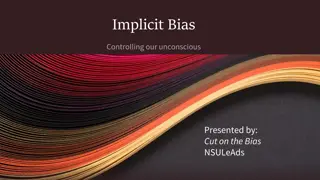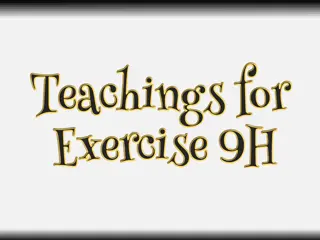Understanding Implicit Bias: Exploring Bias, Stereotypes, and Discrimination
Explore the concept of implicit bias through discussions about prior knowledge, feelings pre and post taking implicit association tests, and how this awareness can be applied beneficially in personal and classroom settings. Definitions of implicit bias, stereotypes, prejudice, and discrimination are explained, along with strategies to combat bias and replace stereotypes with unbiased responses. Resources for further learning and understanding are provided.
Download Presentation

Please find below an Image/Link to download the presentation.
The content on the website is provided AS IS for your information and personal use only. It may not be sold, licensed, or shared on other websites without obtaining consent from the author. Download presentation by click this link. If you encounter any issues during the download, it is possible that the publisher has removed the file from their server.
E N D
Presentation Transcript
UNDERSTANDING IMPLICIT BIAS Arturo Montoya & Brianna Weeks
Ice Breaker Each person take a badge and pin to your shirt somewhere between your waist and neck. When instructed get up and mingle to form new groups.
What is Implicit Bias? Take the Implicit Association Test https://implicit.harvard.edu/implicit/takeatest.html http://kirwaninstitute.osu.edu/implicit-bias-training/ Discuss in Groups What was your prior knowledge of implicit bias? How did you feel prior to taking the test about the topic selected? What were your impressions while taking the test? What did you learn/surprised you about the results? How can you see this knowledge being helpful in your classroom/life?
http://kirwaninstitute.osu.edu/implicit-bias-training/ Yale Child Study (2016) Upjohn Institute for Employment Research (2015)
Implicit Bias: Definitions Implicit Bias is the bias in judgement and/or behavior that results from subtle cognitive processes (e.g, implicit attitudes and implicit stereotypes) that often operate at a level below conscious awareness and without intentional control. -National Center for State Courts: Helping courts address implicit bias-FAQS Policing Health Care Military Schools
Definitions Continued A stereotype is an exaggerated belief, image or distorted truth about a person or group a generalization that allows for little or no individual differences or social variation. Stereotypes are based on images in mass media, or reputations passed on by parents, peers and other members of society. Stereotypes can be positive or negative. A prejudice is an opinion, prejudgment or attitude about a group or its individual members. A prejudice can be positive, but in our usage refers to a negative attitude. Discrimination is behavior that treats people unequally because of their group memberships. Discriminatory behavior, ranging from slights to hate crimes, often begins with negative stereotypes and prejudices.
Confronting Bias Stereotype Replacement: an individual recognizes that he or she is responding to a situation or person in a stereotypical fashion. (S)he considers the reasons and actively replaces this biases response with an unbiased one. Counter-stereotyping Imaging: Once an individual detects a stereotypical response, he or she thinks of examples- either famous or personally known to the person that prove the stereotype to be innacurate Individuating: This strategy involves gathering very specific information about a person s background, tastes, hobbies, and family, so that one s judgements will be based on the particulars of that person, rather than on group characteristics.
Strategies Continued Perspective-taking involves stepping into the shoes of a stereotyped person. For example what does it feel like to have your intelligence automatically questioned or to be followed in a store? This can be useful in assessing the emotional impact on individuals who are constantly being stereotyped in negative ways. Increasing Opportunity for Positive Contact: Reducing implicit bias is to actively seek out situations where one is likely to be exposed to positive examples of groups subject to stereotype. http://kirwaninstitute.osu.edu/implicit-bias-training/
Mindfulness and Implicit Bias Mindfulness practice is another important strategy that can help us transform implicit bias in our daily lives: Commit to a Daily Meditation Practice Use the Triangle of Awareness Set the Intention to Notice Bias Self Educate Practice Self Compassion
Activity Think of a negative interaction that you have had with a student/coworker/supervisor. Fill in your relationship with that person. Fill in your perceptions in regards to the person you were interacting with. Fill in who you think you were in that interaction. Your beliefs and perceptions.
Restorative Justice & Implicit Bias: What is Restorative Justice? Restorative justice is a philosophy based on a set of principles that guide the response to conflict and harm. These principles are based on practices that have been used for centuries in indigenous cultures and religious groups. Three main goals: Accountability. Restorative justice strategies provide opportunities for wrongdoers to be accountable to those they have harmed, and enable them to repair the harm they have caused to the extent possible. Community. Restorative justice recognizes the need to keep the community safe through strategies that build relationships and empower the community to take responsibility for the well-being of its members. Competency development. Restorative justice seeks to increase the pro-social skills of those who have harmed others, address underlying factors that lead youth to engage in delinquent behavior, and build on strengths in each young person.
Restorative Justice in Schools Aims first to build classroom communities that are supported by clear agreements, authentic communication, and specific tools to bring issues and conflicts forward in a helpful way. Aims to provide specific pathways to repair harms by bringing together those who are affected by misbehavior in a dialogue to address concerns, achieve understanding, and come to agreement about setting things right. In addition to serving the cause of fairness and justice, restorative approaches make safer schools and contribute to social and emotional learning. As schools adopt and gain experience with restorative practices several shifts in perspective take place. These shifts don t typically happen all at once. Nor do they typically happen perfectly.
Paradigm Shifts The first shift acknowledges that troublesome behavior is normal, and when students behave in troublesome ways they create opportunities to learn important social and emotional skills. The second shift is a departure from the retributive model in which an authority, after taking testimony from the aggrieved party, decides guilt and assigns punishment. In restorative practices the authority figure acts more as a convener and facilitator. The third shift moves the locus of responsibility for well-being of the community from the shoulders of the experts to the community itself.
Circles Circles are used to intentionally create a space that lifts barriers between people, circles open the possibility for connection, collaboration, and mutual understanding. The circle tradition is derived from aboriginal and native traditions and are built on caring relationships, positive expectation messages, and opportunities for meaningful participation.
Circle Structure & The Talking Piece A circle keeper or facilitator Purpose of the talking piece Language matters
Types of Circles & When to Use Circles Community Building Circles (Proactive Circles) Build social capital, make agreements set expectations, build or monitor academic content. Problem solving, reflection Beginning of day/end of day; unstructured time; new student/student farewell Conflict Resolution/Restorative Circles (Responsive Circles) Brainstorm solutions, develop support plans/agreements, reintegrate students after absences due to suspension etc. When a student has been removed from class, parent/teacher conferences, to address classroom wide issues. Healing Circles Diffusing tensions, debriefing violent or traumatic events. After major disruption, community/national tension events, discussing sensitive topics
Activity A father and son were involved in a car accident in which the father was killed and the son was seriously injured. The father was pronounced dead at the scene of the accident and his body was taken to a local morgue. The son was taken by ambulance to a nearby hospital and was immediately wheeled into an emergency operating room. A surgeon was called. Upon arrival and seeing the patient, the attending surgeon exclaimed Oh my God, it s my son! Can you explain this?
Resources Claassen, Ron, and Roxanne Claassen(2008). Discipline That Restores: Strategies to Create Respect, Cooperation, and Responsibility in the Classroom. South Carolina: Ron and Roxanne Claassen, Print. Circle Planning Guide: Circle Templates and other info. OUSD Community Schools, Thriving Students.Accessed 9.3.18 https://sites.google.com/a/ousd.k12.ca.us/ousd-rj- resources/ Hermanns, Carl. (2016) Moving From Punitive to Restorative Discipline: Exploring Assumptions and Beliefs. Mary-Lou Foulton Teacher s College. Arizona State University. Powerpoint file. Implicit Bias Module Series (2019). Kirwan Institute for the Study of Race and Ethnicity. Ohio State University. http://kirwaninstitute.osu.edu/implicit-bias- training/ Take a Test (2019). Project Implicit. Harvard. https://implicit.harvard.edu/implicit/takeatest.html























